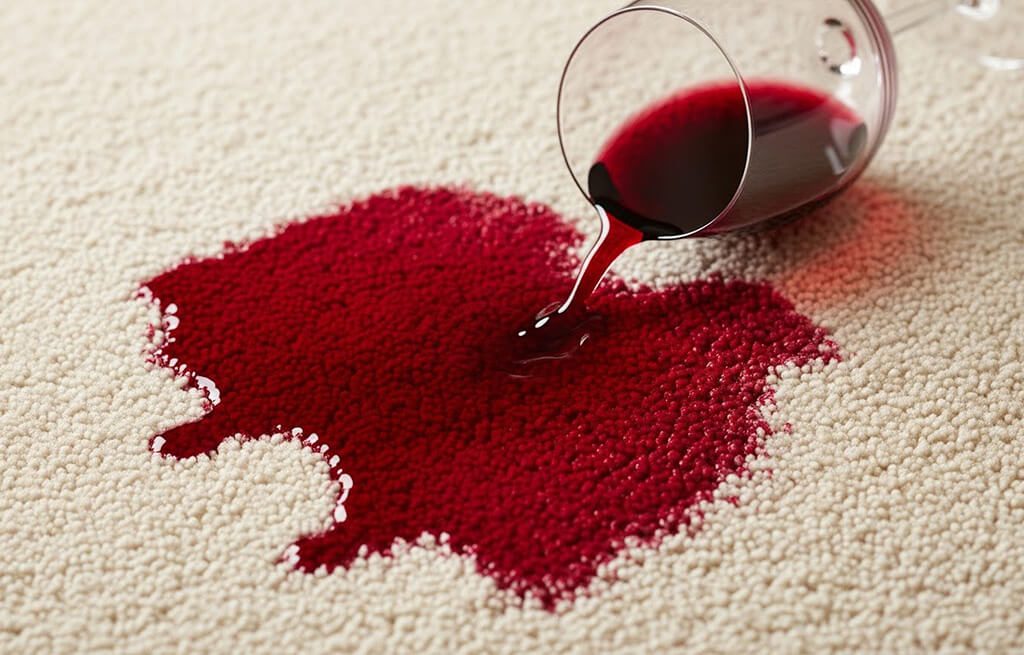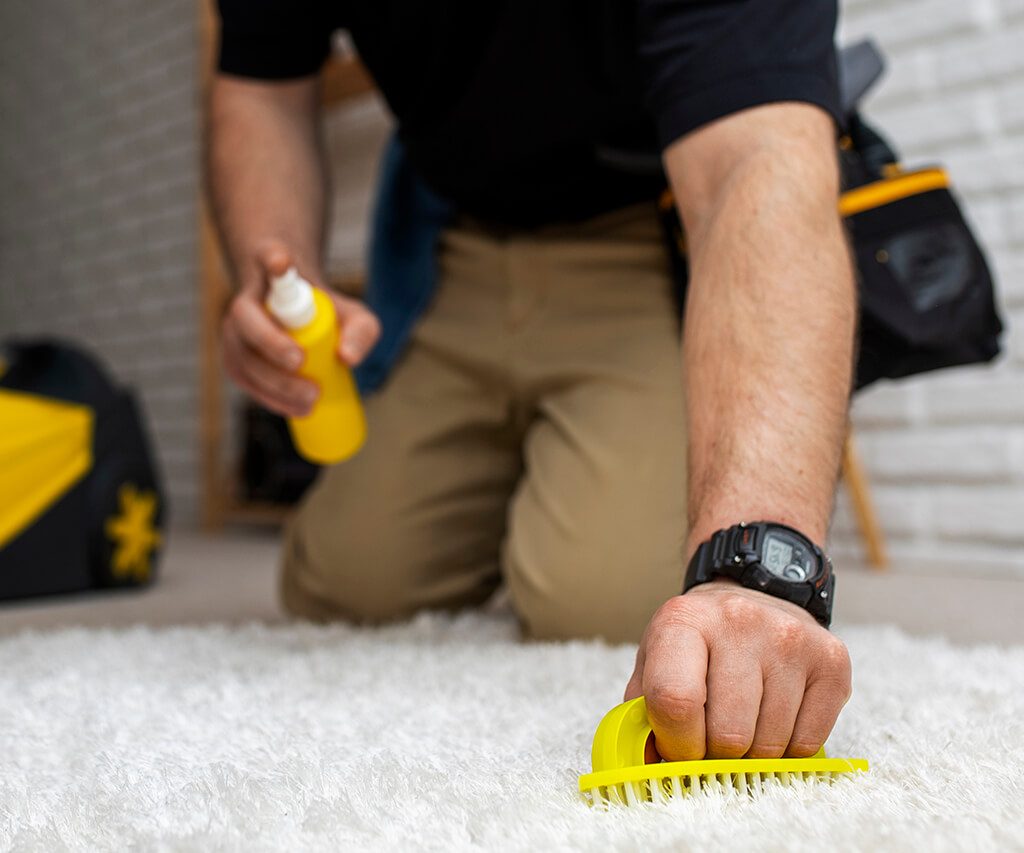How to Get Red Wine Out of Carpet
Red wine spills are one of the most common and stubborn carpet accidents. In Canada and the US, professional cleaners report that wine stains are among the top five most difficult stains to remove from household textiles.

The deep red hue of wine comes from anthocyanins, water-soluble pigments that bind quickly to carpet fibres. Once they polymerize, they become stable, complex molecules that resist removal. This means timing and method are critical in deciding whether a red wine spill becomes a permanent mark or a temporary setback.
This guide explains how to get red wine out of carpet using methods supported by chemistry and professional cleaning standards. You’ll learn why immediate action matters, how to remove red wine stains with safe at-home techniques, and when professional help is the better choice.
The Science of Red Wine Stains
Why Red Wine Stains Carpets So Easily
Red wine contains anthocyanins, pigments that are red in acidic environments like wine (pH around 3). When wine lands on a carpet, the pigments penetrate the fibres in their soluble form. If left untreated, they react with tannins and oxygen, forming larger molecules that lock into the fibres. Heat accelerates this process, which is why hot water should never be used on a fresh spill.
Environmental Factors
- pH: Anthocyanins are red in acidic solutions but can turn colourless in neutral conditions.
- Time: The longer the wine sits, the more the pigments polymerize.
- Temperature: Heat speeds up pigment binding and makes removal harder.
This explains why quick action is the strongest predictor of success in carpet stain removal.
How to Remove Red Wine Stains
Act Fast
The first rule in getting wine out of carpet is to start immediately. Blotting with a clean, white cloth or paper towel absorbs liquid before it sets. Rubbing is discouraged, as it pushes the stain deeper and makes it larger.
Blot, Don’t Rub
Capillary action works in your favour when blotting. Start from the outer edge of the stain and work inward to prevent spreading.
Beware of Wicking
Even after a stain looks gone, it may reappear. This happens when wine seeps into the carpet padding, then rises back as moisture evaporates. Using a wet/dry vacuum or hydrogen peroxide on reappearing spots can prevent this effect.
If stains keep reappearing or your rug looks dull overall, it may be one of the signs that your rug needs professional cleaning.Common Methods for Red Wine Stain Removal
Common Methods for Red Wine Stain Removal

The following table summarizes the three main at-home approaches:
| Method | How It Works | Materials Needed | Pros | Risks/Cons |
| Oxidative | Breaks pigment molecules with oxygen radicals | 3% hydrogen peroxide, dish soap, water | Effective, colour-safe on most synthetics | May bleach wool and silk; patch test required |
| pH-Differential | Changes pigment colour through acid-base reaction | Vinegar, baking soda, water | Uses household items, foam lifts pigment | Vinegar may damage fibres, not ideal long-term |
| Detergent/Dilution | Surfactants lift pigment; carbonation loosens fibres | Club soda, mild dish soap, water | Gentle, safe for most fibres | Less effective on older, set stains |
The Oxidative Method: Hydrogen Peroxide
Hydrogen peroxide is one of the most effective solutions for red wine stain removal. It oxidizes anthocyanins, breaking down the chromophores that give them colour.
- Application: Apply 3% hydrogen peroxide directly or mix with dish soap (3:1 ratio). Let it sit for 20–60 minutes before blotting.
- Fibre Considerations: Safe on synthetic carpets (nylon, polyester), but risky on wool and silk. Always patch test before use.
The pH-Differential Method: Vinegar and Baking Soda
This method works by shifting the stain’s pH from acidic to neutral, converting the pigments to a colourless form. The bubbling reaction also helps lift the pigment from fibres.
- Application: Mix vinegar and baking soda into a paste, gently work it into the stain, then rinse with cool water.
- Risks: Professional cleaners warn that vinegar’s acidity can damage natural fibres and fade colours over time. This method should be used only as a temporary fix, not a long-term solution.
The Detergent and Dilution Method: Club Soda and Soap
Surfactants in soap lower the water’s surface tension, allowing it to penetrate fibres and lift pigments. Club soda adds carbonation, which physically loosens the stain.
- Application: Blot with water or club soda first. If the stain persists, apply a mixture of a few drops of clear dish soap in one cup of water, then blot again.
- Best Use: This is the safest first step, especially on delicate fibres.
Many of the same household methods that work for wine can also apply to other spills, which is why general advice on how to get stains out of carpet is often built on the same principles of blotting, dilution, and careful use of cleaning agents.
Carpet Fibre Considerations
Different carpets require different approaches:
- Synthetic (nylon, polyester): Best cleaned with hydrogen peroxide or detergent-based methods. These fibres resist bleaching, making oxidative approaches safe.
- Natural (wool, silk): Use only mild detergent and cool water. Strong acids (vinegar) and oxidizers (hydrogen peroxide) can permanently damage these fibres.
When to Call a Professional
If the red wine spill on carpet involves valuable rugs (such as Persian or wool carpets) or has been left untreated for too long, professional cleaning is recommended. Certified cleaners use extractors, enzyme solutions, and controlled pH agents that go beyond household remedies.
FAQs
How to remove a red wine stain if it has dried?
For dried stains, start with the detergent method, then move to hydrogen peroxide. Dried pigments are more stable, so oxidation is often required for full removal. This approach works even when dealing with a red wine carpet stain that has been left too long.
How to remove wine stains without chemicals?
Blot with water or club soda, followed by a mild soap solution. While this may not fully eliminate a deep stain, it reduces pigment load safely. This is the safest option if you are worried about damaging fibres after spilling red wine on the carpet.
How to get wine out of carpet quickly?
Blot immediately, apply club soda, then follow up with either a soap solution or hydrogen peroxide if colour remains. Acting within minutes is the most important factor, especially if you want to stop red wine stains on your carpet from becoming permanent.
Conclusion
Understanding the chemistry behind red wine stains explains why they are so persistent. Anthocyanins bind quickly and permanently if left untreated, which is why immediate blotting is essential. Methods like hydrogen peroxide, vinegar with baking soda, and club soda with detergent each have their place depending on the carpet type and stain age.
The most effective approach is tiered: blot, dilute, use detergent, and escalate to oxidation only if needed. Knowing how to get red wine out of carpet avoids long-term fibre damage. For delicate materials or old stains, professional cleaning remains the safest solution.
Need Professional Help?
For tough stains or delicate rugs, see our rug cleaning prices and get expert care tailored to your carpet or rug.
Cuz Sharing is Caring
You May Also Like

How to Get Red Wine Out of Carpet
Red wine spills are one of the most common and stubborn carpet accidents. In Canada and the US, professional cleaners report that wine stains are among the top five most

How to Get Stains Out of Carpet
Stains on carpet don’t just make your home look messy. If you don’t deal with them properly, they can sink into the fibres, become harder to remove, and affect the


